616 - Spinal cord injuries 2/28
Define spinal cord injury
Spinal cord injuries involve damage to your spinal cord -- this bundle of nerves links your brain to nerves throughout your body
- Damage to your cord can interrrupt sensory signals and control over muscle movement
Causes of spinal cord injuries
- what is the leading cause for younger individuals?
Trauma
- Motor vehicle accidents = leading cause for younger individuals
- Falls - people over 65
- Acts of violence
- Sports and recreational activities
1/67
There's no tags or description
Looks like no tags are added yet.
Name | Mastery | Learn | Test | Matching | Spaced |
|---|
No study sessions yet.
68 Terms
Define spinal cord injury
Spinal cord injuries involve damage to your spinal cord -- this bundle of nerves links your brain to nerves throughout your body
- Damage to your cord can interrrupt sensory signals and control over muscle movement
Causes of spinal cord injuries
- what is the leading cause for younger individuals?
Trauma
- Motor vehicle accidents = leading cause for younger individuals
- Falls - people over 65
- Acts of violence
- Sports and recreational activities
T/F: more than half of SCI occur in ppl age 16-30
True
Most are SCI are ____________ (female/male)
male
- males also represent nearly all of sports related injuries
How do spinal cord injuries occur in football?
When the head is used as an offensive weapon, as when one player tackles another or when a ball carrier is driven into the ground
- a player is especially vulnerable when the force of contact is sent directly down the spinal column
Define complete SCI vs incomplete SCI
Complete SCI:
- No function below the level of injury and includes both sensation and voluntary movement - both sides of the body are equally affected
Incomplete SCI:
- Some function below primary level of injury
- May be able to:
-- move one limb more than another
-- feels parts of the body that cannot be moved
-- have more functioning on one side than the other
American Spinal Injury Association classification (ASIA)
Complete = no motor, no sensory
Incomplete = may have one or the other

Types of spinal cord injury
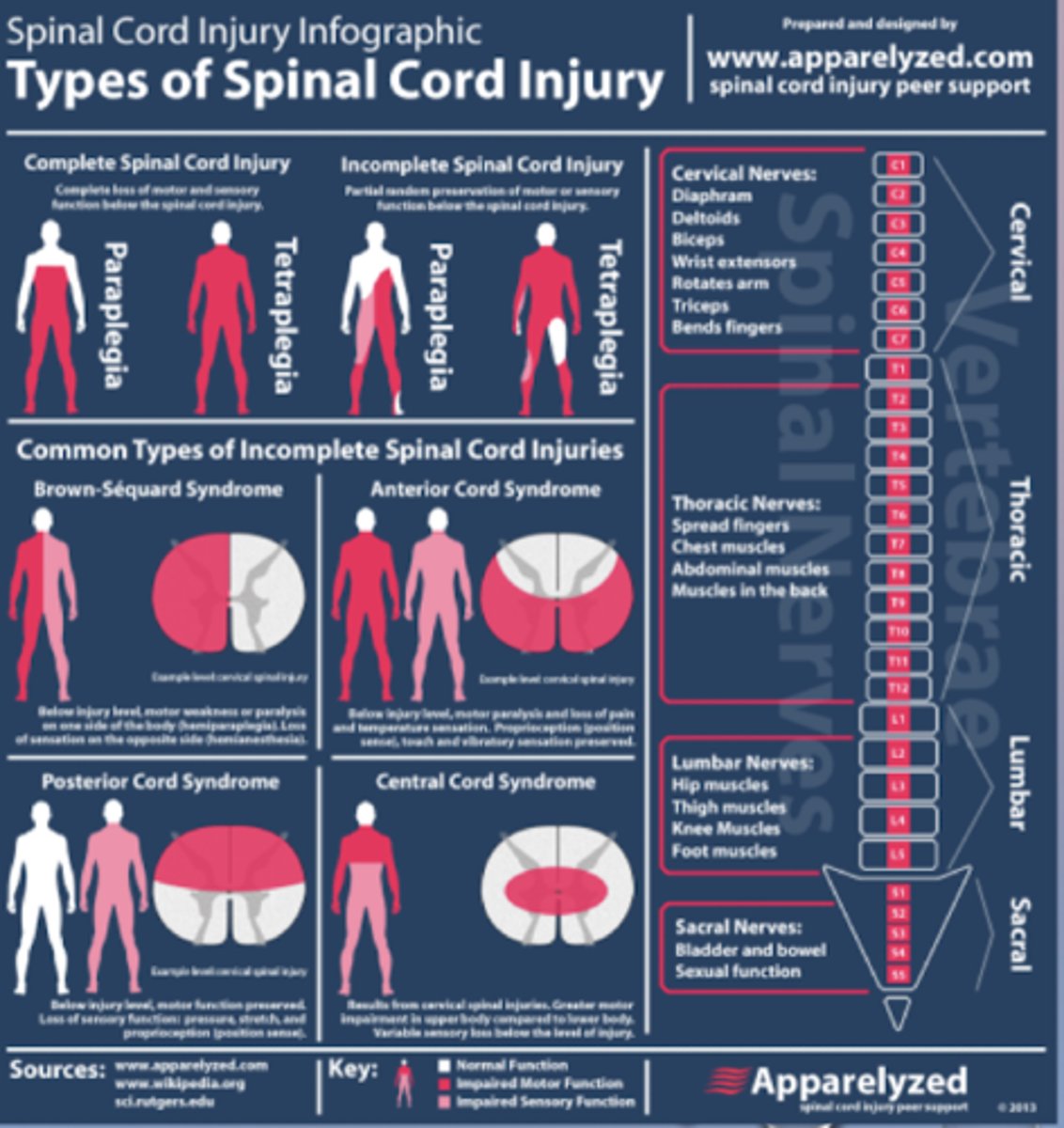
Consequences of autonomic system injury (4)
- Bladder control
- Bowel control
- Vasomotor control
- Sexual function
Emotional impact of paralysis
- ___________ is common
- Depression is common and they go through a grief period (shock, denial, reaction, mobilization, and coping)
- Go through stages of adjusting
Stages of adjusting following SCI (5)
- Grieving
- Taking control
- Talking about your disability
- Taking care of yourself
- Looking ahead
SCI morbidity (5)
- Respiratory complications (pneumonia, PE)
- Urinary and cutaneous complications
- Septicemia
- Heart disease
- Trauma, suicide, and alcohol related deaths
Adaptive devices for SCI
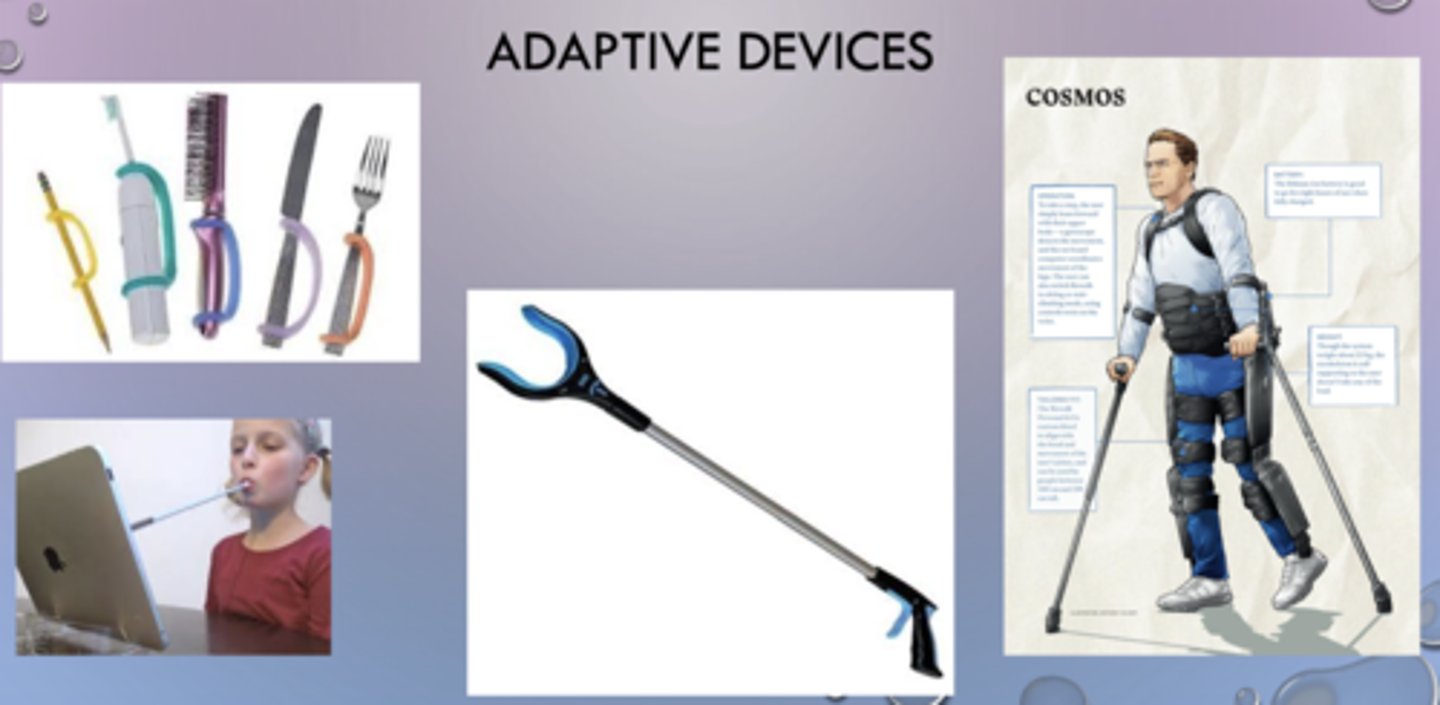
Dental adaptations for quadriplegic pt
Mouth stick for quadriplegics
- can help with turning pages, drawing, typing, and other functions
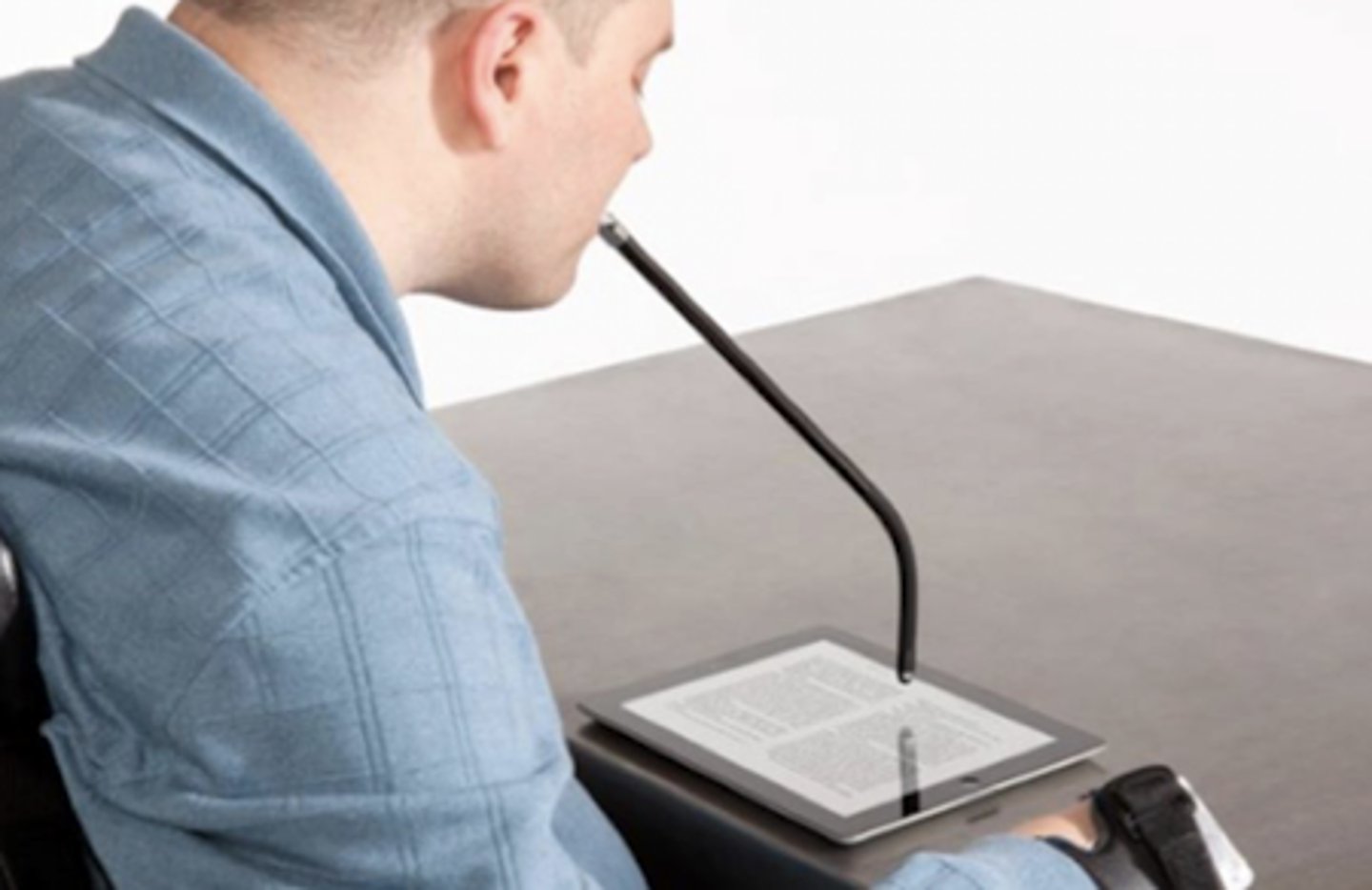
Special considerations for dental txt for pts w SCI
- Respiration may be compromised
- Oral reflexes such as coughing or gagging may be diminished
- Sensory systems below site of injury are impaired
- Decubitus ulcers (pressure sores) develop easily when the pt remains in one position for prolonged periods
Define stroke
Occurs when a blood vessel that carries oxygen and nutrients to the brain is either blocked by a clot or bursts (or ruptures)
= Cerebrovascular accident
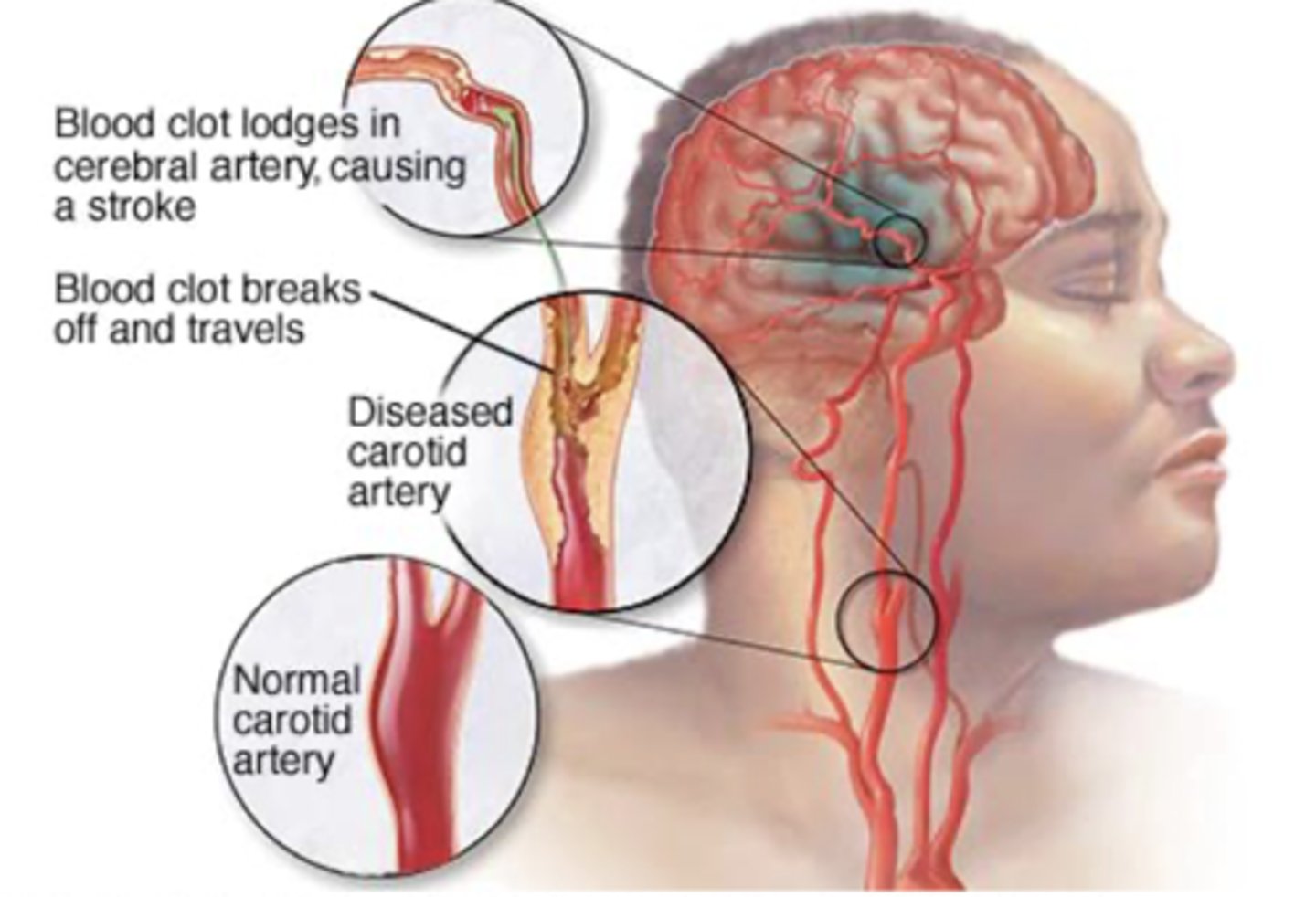
Stroke is the #_______ cause of death and leading cause of disability in the US
5
____% of strokes are preventable
80
What population is twice as likely to experience stroke?
Black adults
Types of strokes (5)
- Ischemic (clots)
- Hemorrhagic (bleeds)
- Transient ischemic attack (TIA)
- Cryptogenic stroke (unknown cause)
- Brain stem stroke (locked state-unable to speak or move)
Define ischemic stroke
- ______% of strokes
Clot of mass clogs a blood vessel, cutting off the blood flow to the brain cells
- 87% of all strokes
- transient ischemic attack (TIA) = a mini stroke and is of short duration
Define hemorrhagic stroke
- ______% of strokes
- Blood vessel bursts in the brain (intracerebral). Blood accumulates and compresses the. surrounding brain tissue
- 13% of strokes
- most common cause = uncontrolled BP
Signs of a stroke
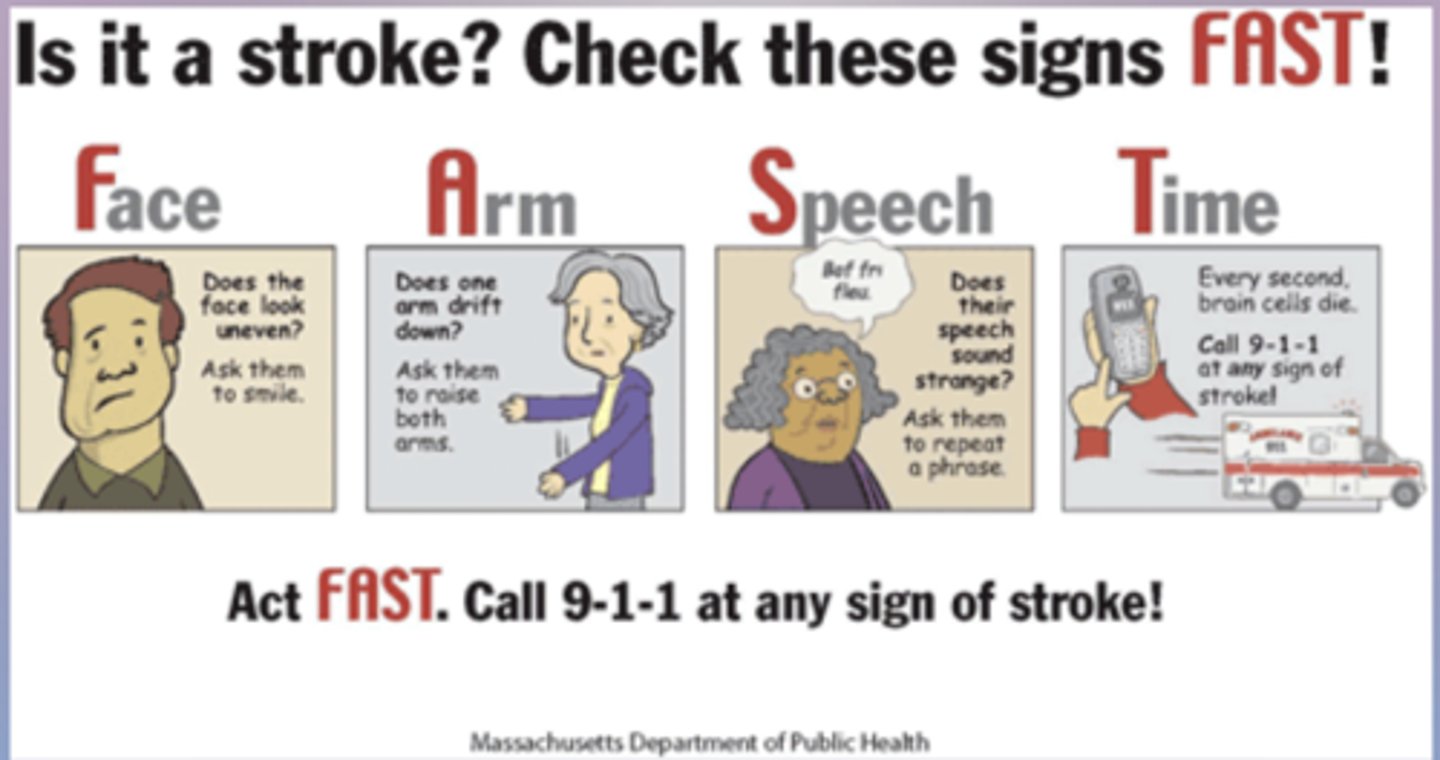
Stroke symptoms
- Sudden numbness of face, arm, leg, esp on one side of the body
- Sudden confusion
- Sudden trouble seeing
- Sudden trouble walking
- Sudden severe headache
Residual effects of a stroke in the left brain vs right brain
Left brain:
- if the stroke occurs in the left side of the brain, the right side of the body will be affected, producing all or some of the following:
-- paralysis on the right side of the body
-- speech/language problems
-- slow, cautious behavioral style
-- memory loss
Right brain:
- Left side of the body will be affected, producing some or all of the following:
- paralysis on the left side of the body
- vision problems
- quick, inquisitive behavioral style
- memory loss
Define aphasia
Loss of ability to express or understand wirtten and spoken langugae due to brain damage
- speech therapy and use of pictures
Define dysarthria
Disorder of the motor component of speech resulting in slurred or explosive speech
Define apraxia of speech
Unable to perform a movement or task when asked despite having the desire and physical ability
- hard to initiate speech
Define agnosia
Loss of the ability to identify objects or people due to a processing disorder of the brain
Questions to assess a patient that has had a stroke
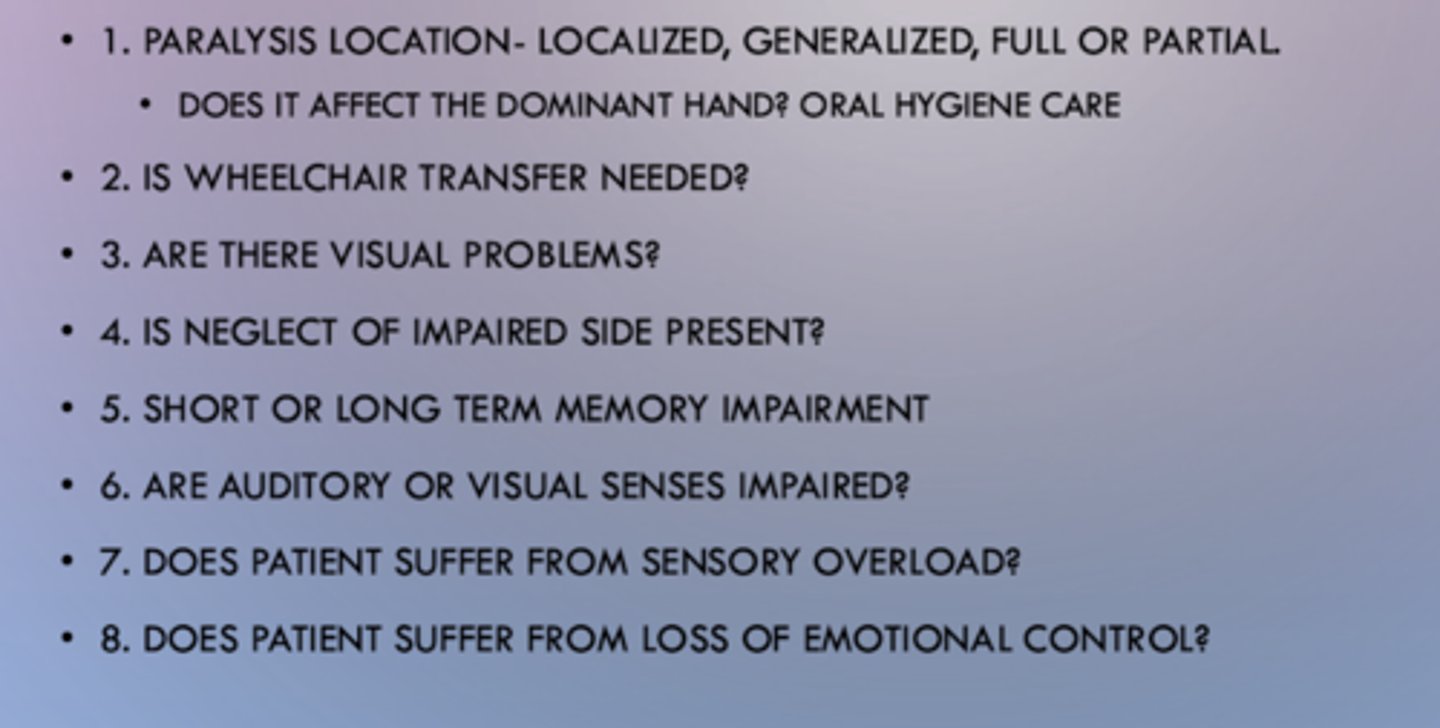
1 in ______ stroke survivors will have another stroke
4
- the change of having another stroke within 90 days of a TIA is 17%, with the highest risk of occurrence during the first week
Dental considerations for pts w/ stroke
- best if appointments are mid-day and short duration
- medications should be taken before the appointment
- many are on anticoagulants
Risk factors for a stroke
- Heart disease
- High blood pressure
- Atrial fibrillation (fast, irregular heartbeat)
- High cholesterol
- Diabetes
--> important to make sure they are taking their medications as prescribed to prevent a recurrent stroke
What is a wheelchair transfer?
When you move a person in or out of a wheelchair
- may need to use transfer aids (gait belt, sliding board, or a mechanical lift)
How to avoid injury during wheelchair transfer?
- Ask for help if needed--> person may be heavy or begin to fall while you are moving them
- Use good body mechanics (refer to pic)
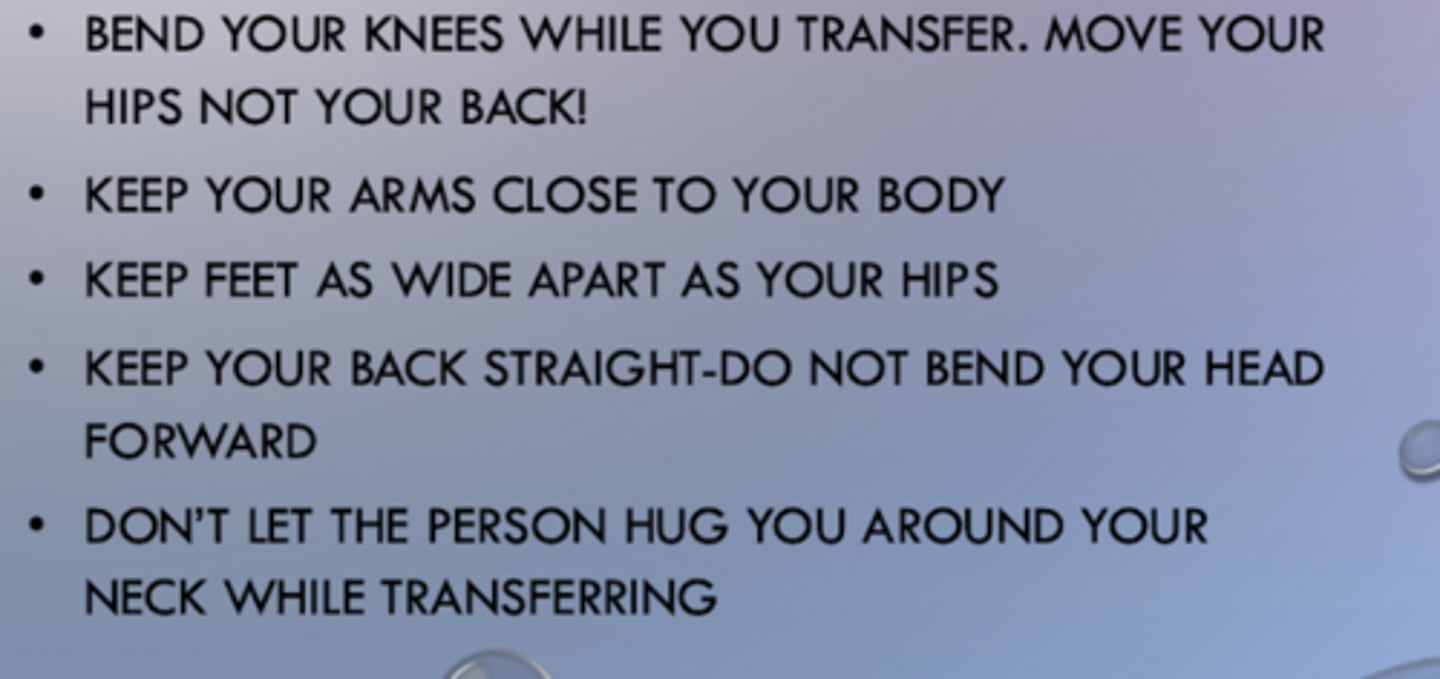
Safety tips for wheelchair
- Lock the wheels before transfer
- Move the foot rests before moving and make sure the persons feet are resting on the floor before moving
- If the person begins to fall, bend your knees and lower them slowly to the nearest safe surface
Who among us are the most at risk of abuse?
= who can least defend themselves
1. Infants
2. Children
3. Elderly
4. People with disabilities
5. People that were abused or neglected as children and are abusers
Children with disabilities are ~_______x more likely to be maltreated than are children without disabilities
3x
- parents can more easily become stressed with demands placed on them by parenting a child with a disability
T/F: Children with behavior problems, like ADHD are more likely to experience physical abuse
True
- bc parents can become frustrated by the child's difficult behavior and respond harshly
A person commits child abuse if he or she knowingly, intentionally, or negligently causes or permits a minor child to be:

T/F: Professionals are required to report child maltreatment
True
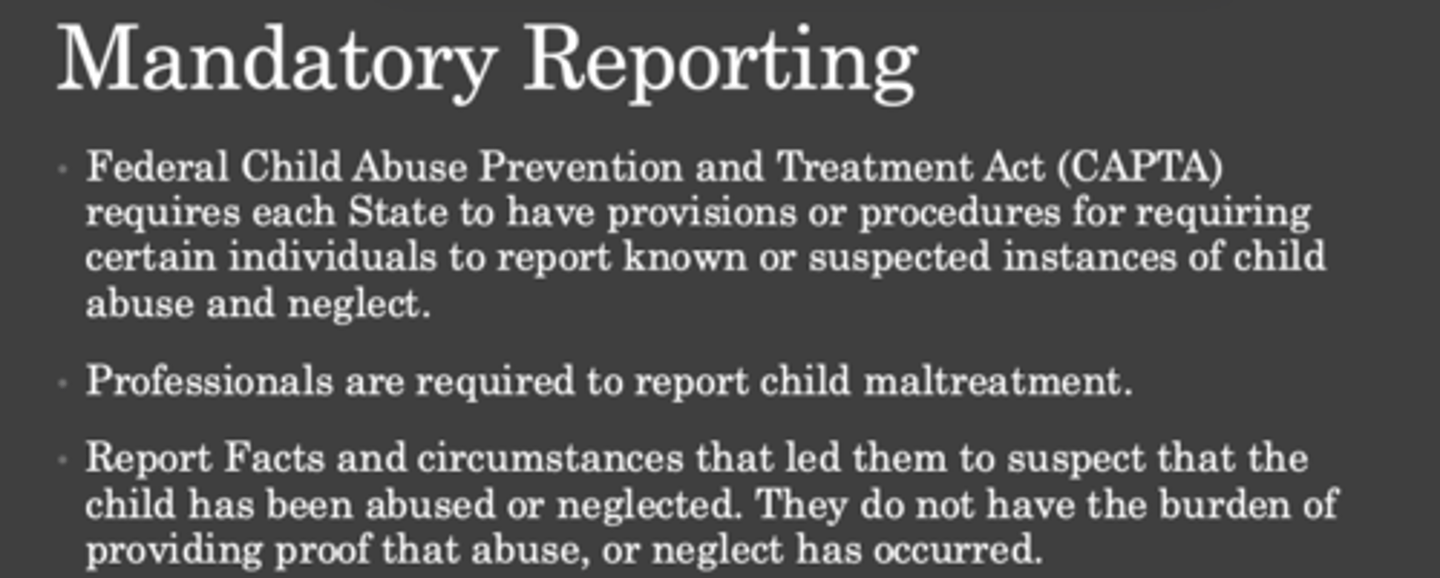
What are "mandatory reporters"?
Professionals who, in the ordinary course of their work and bc they have regular contact qw children (or other vulnerable populations) are required by law to report their observations or suspicions concerning possible child abuse
- NC law requires mandated reporters to report child abuse
Steps to take if you suspect a child is being abused or neglected
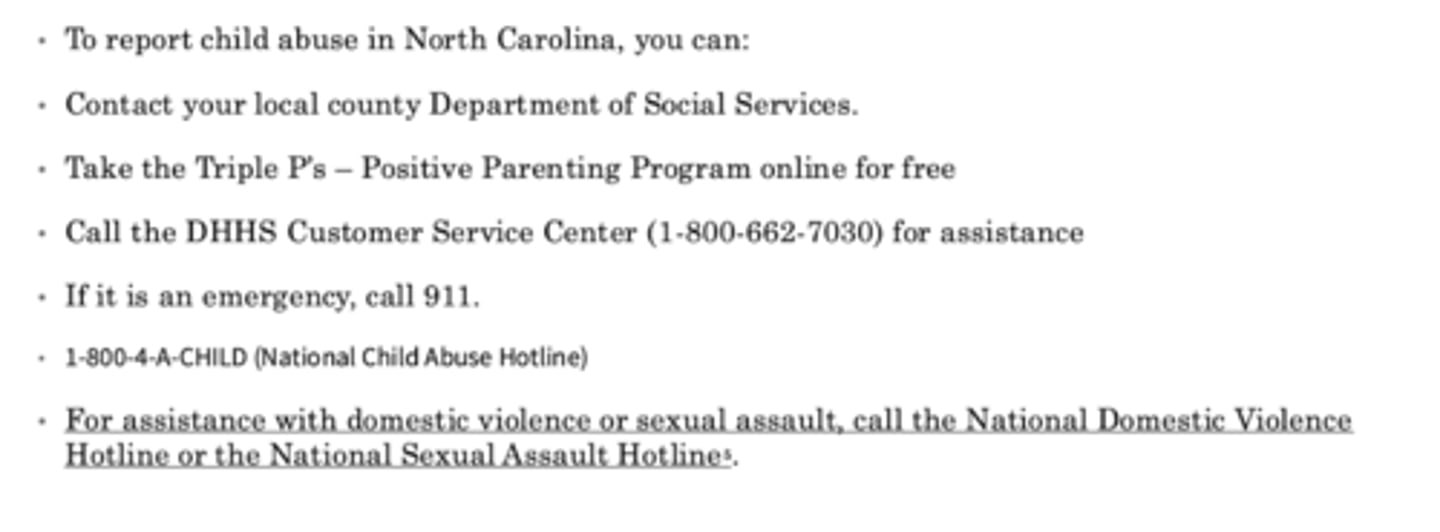
Ten signs of an abusive person
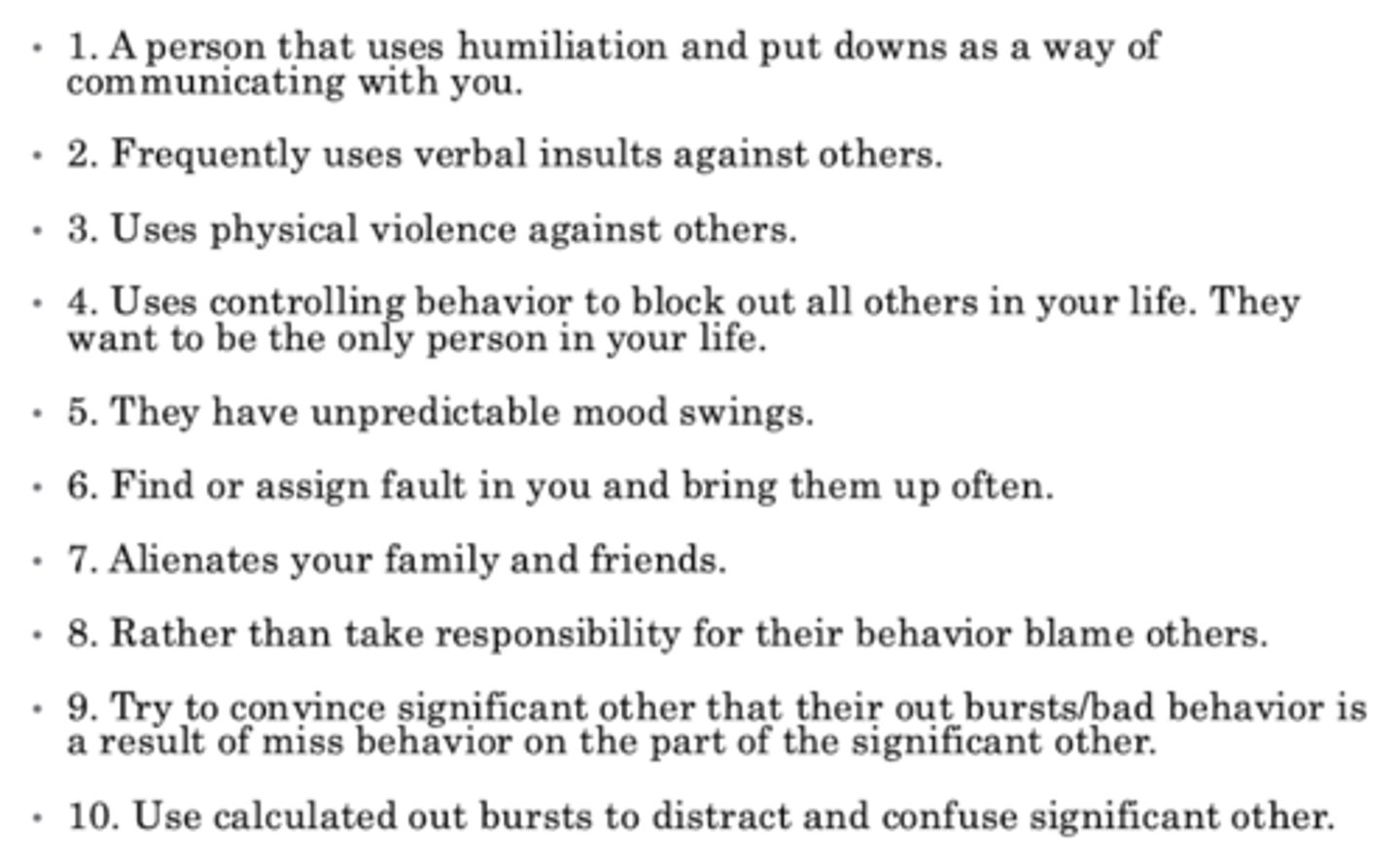
Factors for increased risk of maltreatment
- Environmental factors can add to a parent's stress --> parents who are isolated and who have low levels of social support
- Poverty, unemployment, low maternal education, and single parenting
- Adult intimate partner violence and child maltreatment are closely linked
Abuse comes in many forms: (4)
- Physical
- Emotional
- Sexual
- Neglect
Forms of physical abuse (5)
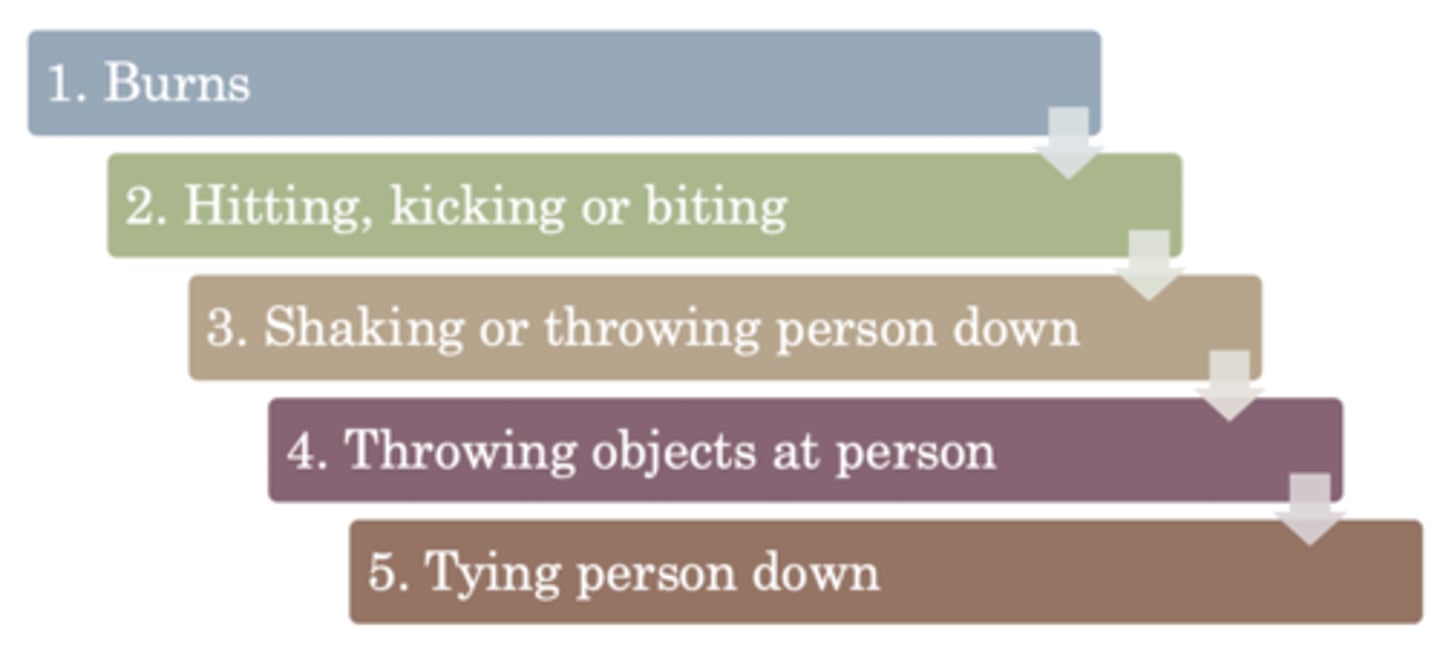
Craniofacial, head, neck, and face injuries occur in _________ of child abuse cases
more than half
Most common site of inflcited oral injuries
- Lips (54%)
- followed by oral mucosa, teeth, gingiva, and tongue
T/F: Crying is a common trigger for child abuse and is the most common trigger for abusive head trauma
True
7 "deadly sins" of childhood devlopment phases
- Colic
- Awakening at night
- Separation anxiety
- Normal exploratory behavior
- Normal negativism
- Normal appetite
- Toilet training resistance
--> these are all normal, but if unprepared, may lead to abuse
When can discipline become abusive?
When punishment is used inappropriately in response to a child's developmentally normal behaviors
- unprepared parents may mistake these normal developmental phases for abnormal behaviors, or unacceptable behaviors and resort to punitive measures to correct them
People that have been physically abused may...
1. Avoid any kind of physical contact
2. Be afraid to go home
3. Seem to be on high alert
- 4. Wearing clothing that does not match the season (cover bruises)
5. Withdaw from friendsna dad activities
Questions to ask if contemplating abuse
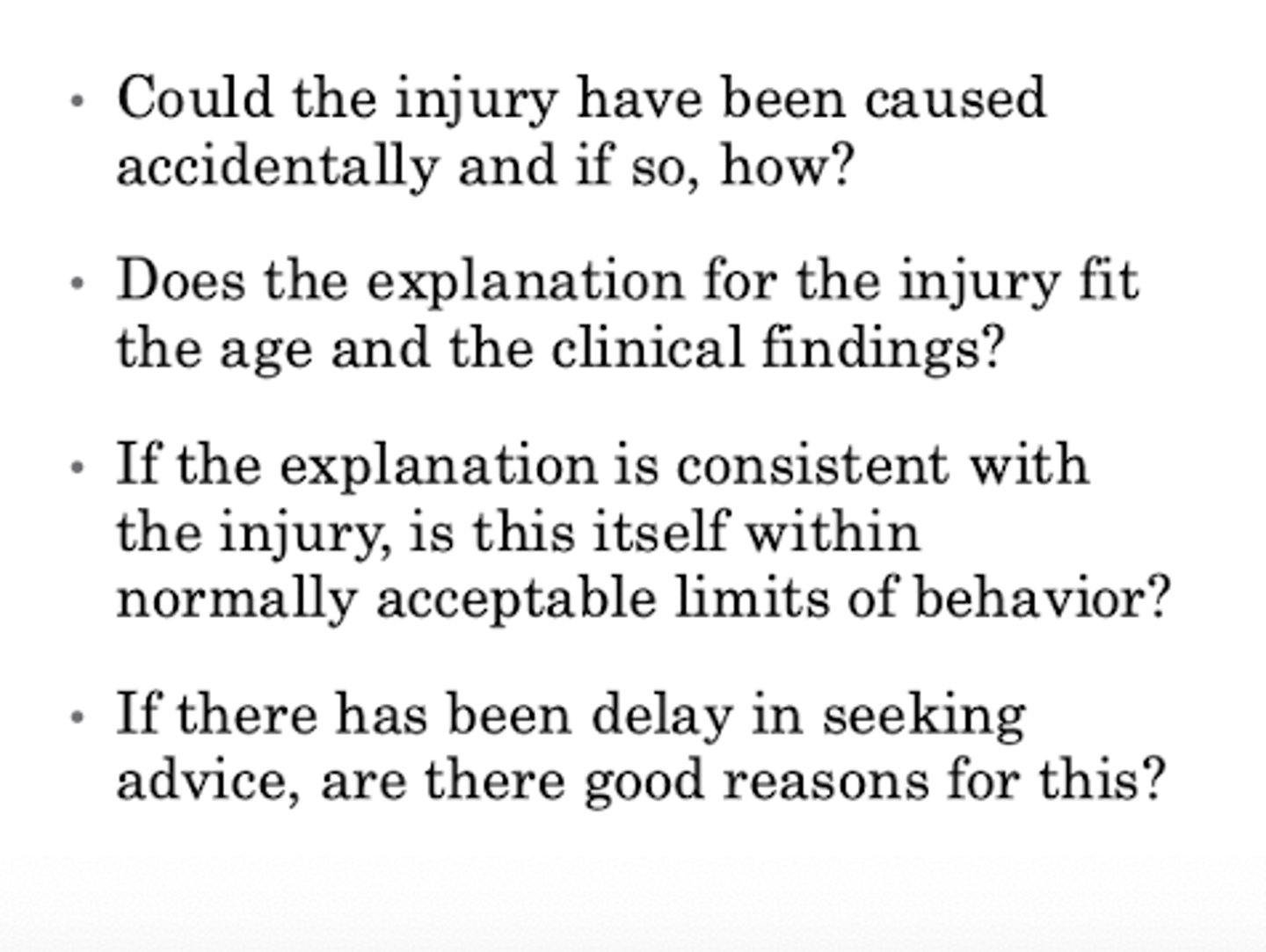
Specific signs to look for physical abuse
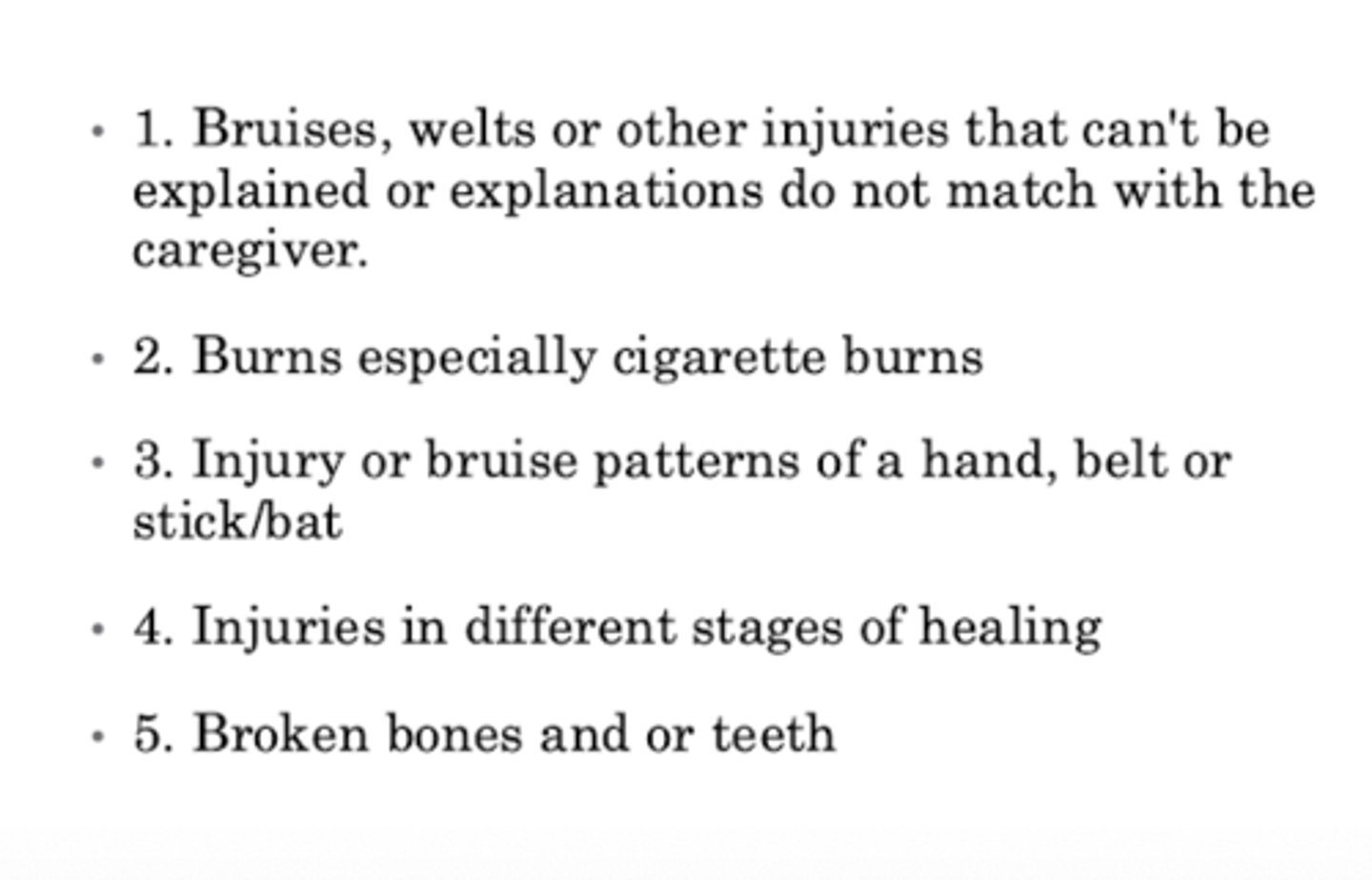
Why is oral cavity a central focus for physical abuse?
Bc of its significance in communication and nutrition
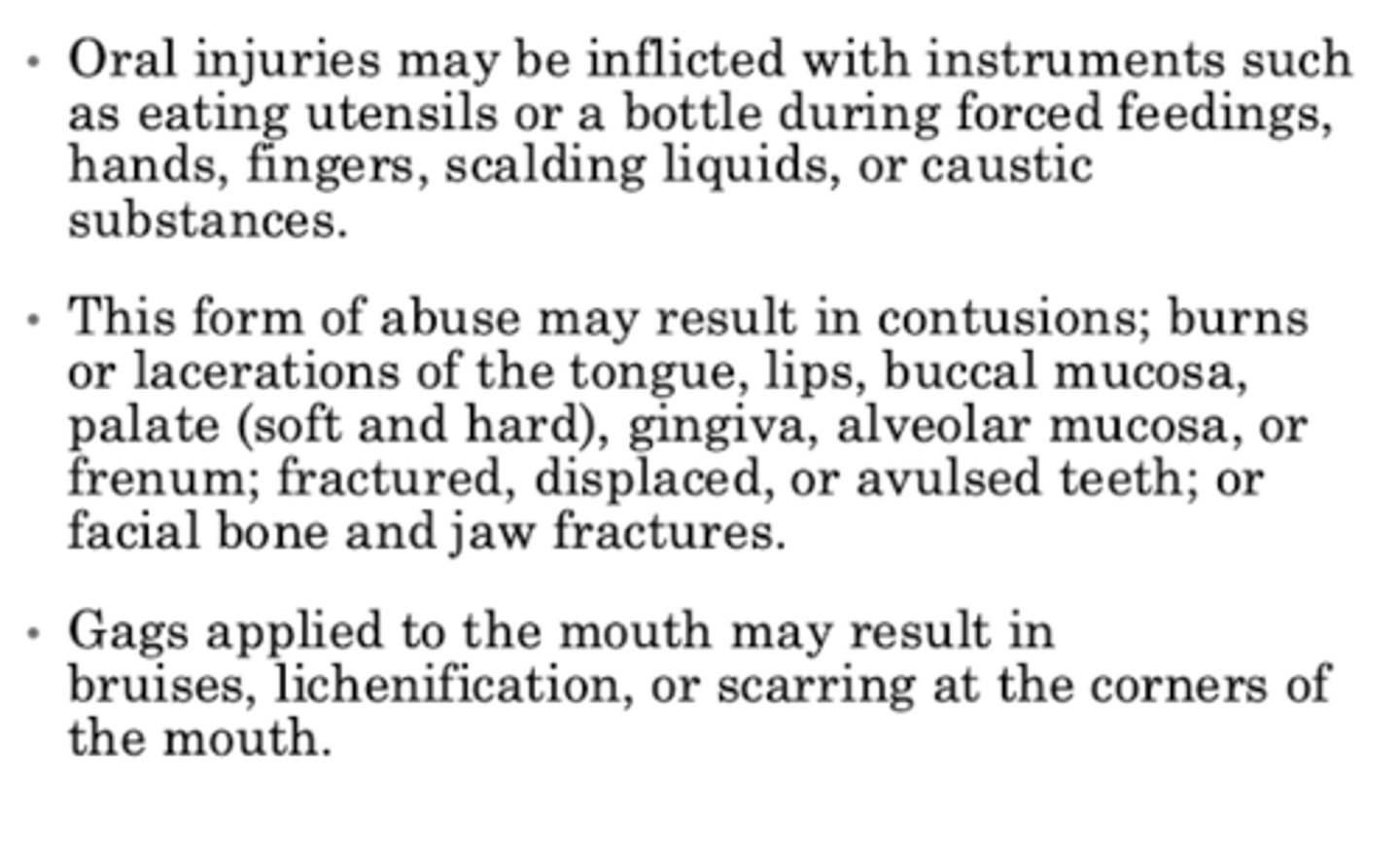
Signs of bite marks
Ecchymoses, abrasions, or lacerations are found in elliptical, horseshoe shaped, or ovoid pattern
HUman trafficking
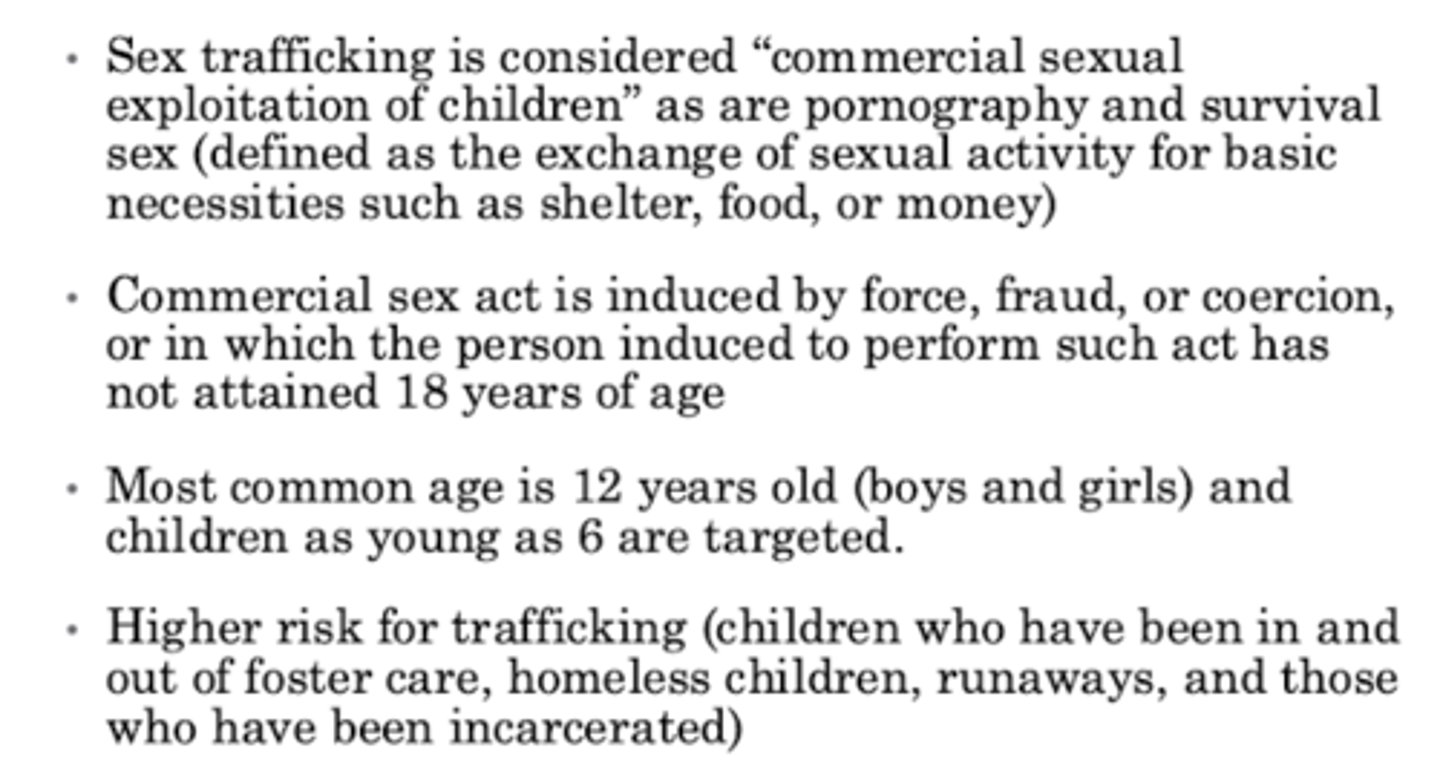
Components of emotional abuse
1. Abuses people or animals in front another
2. Fails to show love
3. Shames, belittles, criticizes, or embarrasses in front of others or in private
4. Threatens, bullies, or yells at others
Signs of emotional abuse
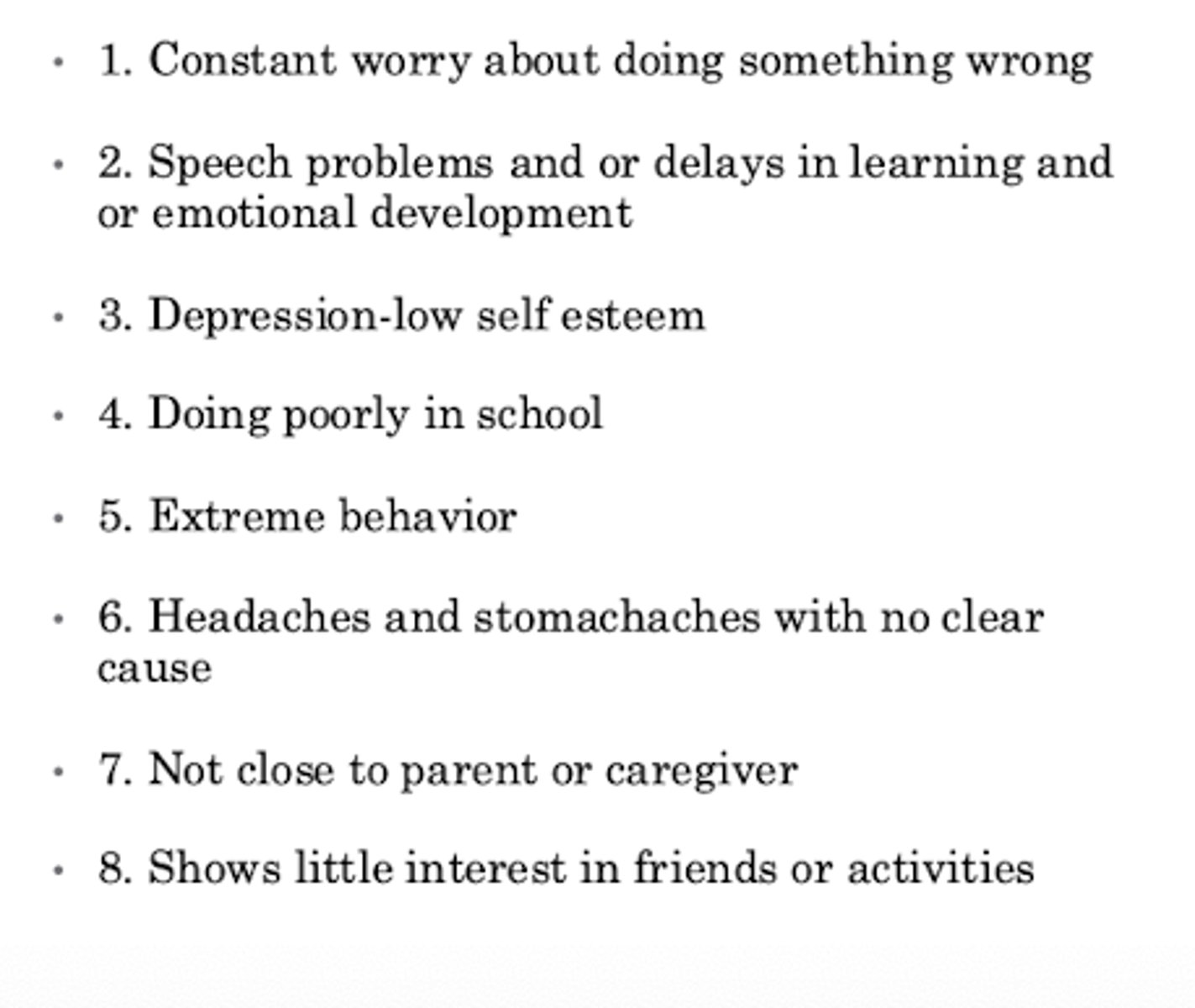
Components of sexual abuse (6)
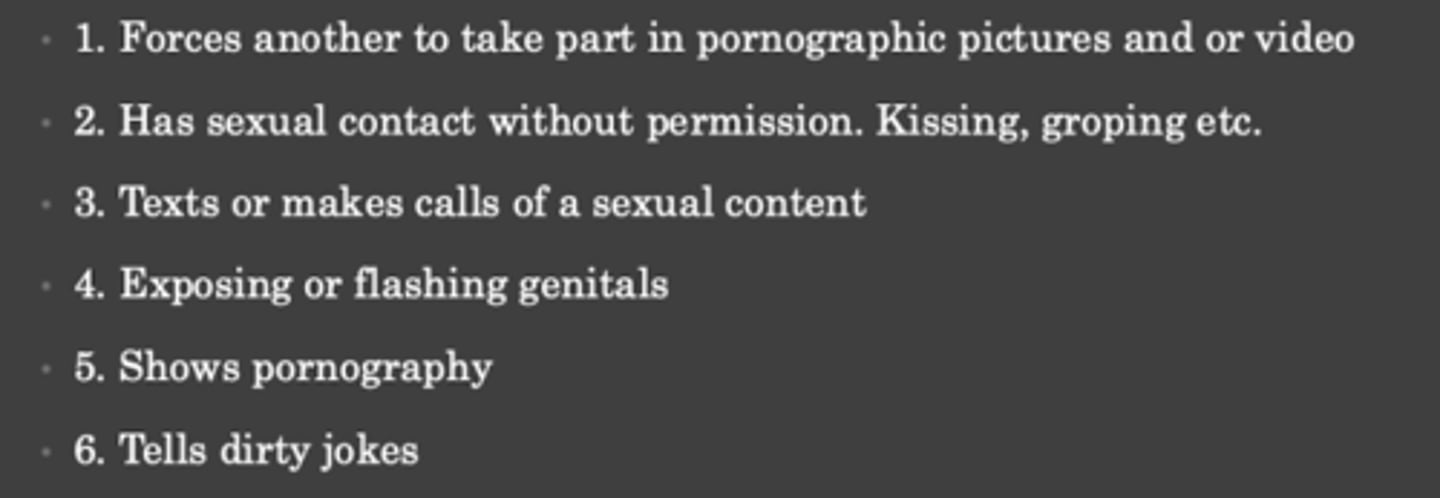
Signs of sexual abuse
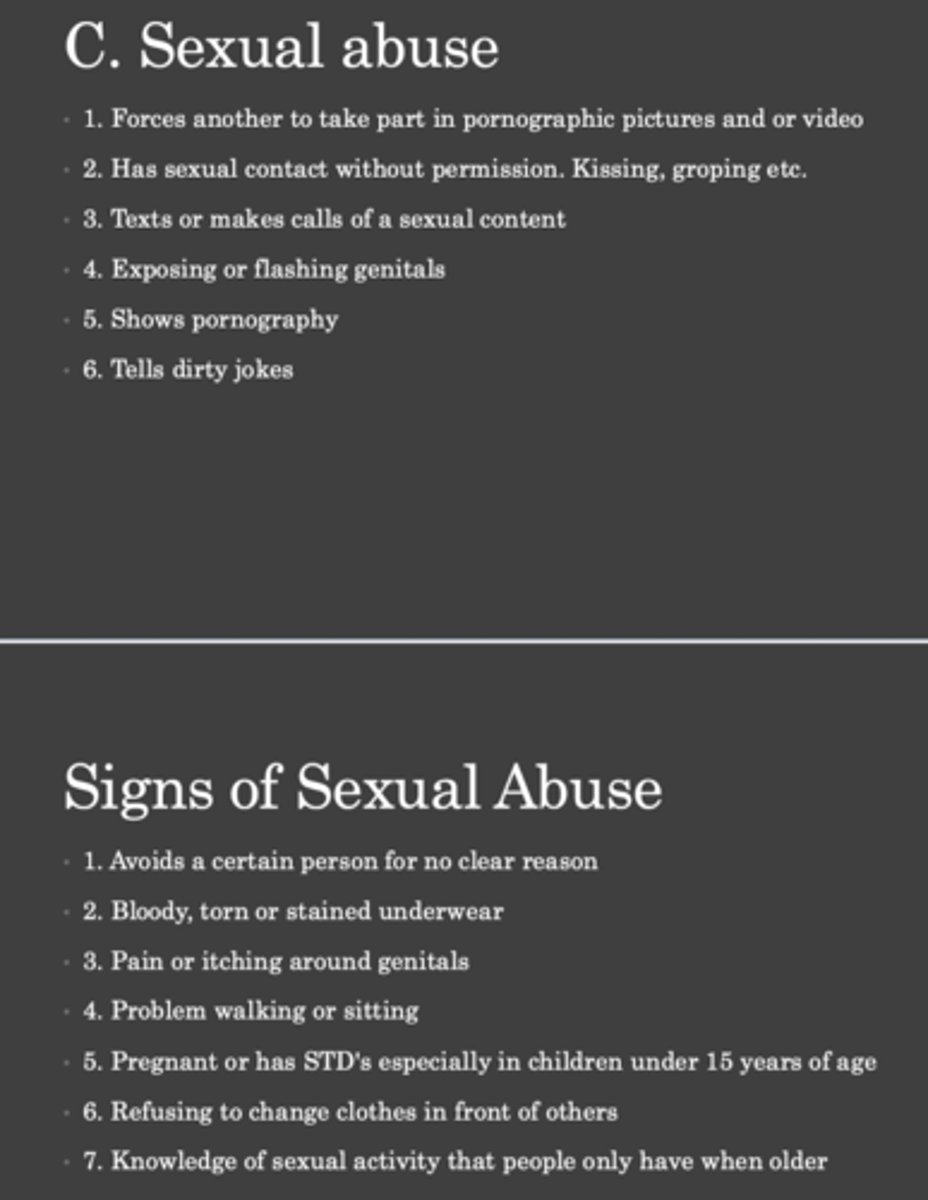
Intraoral sign of forced oral sex
Unexplained injury or petechiae of the palate at junction of hard and soft palate
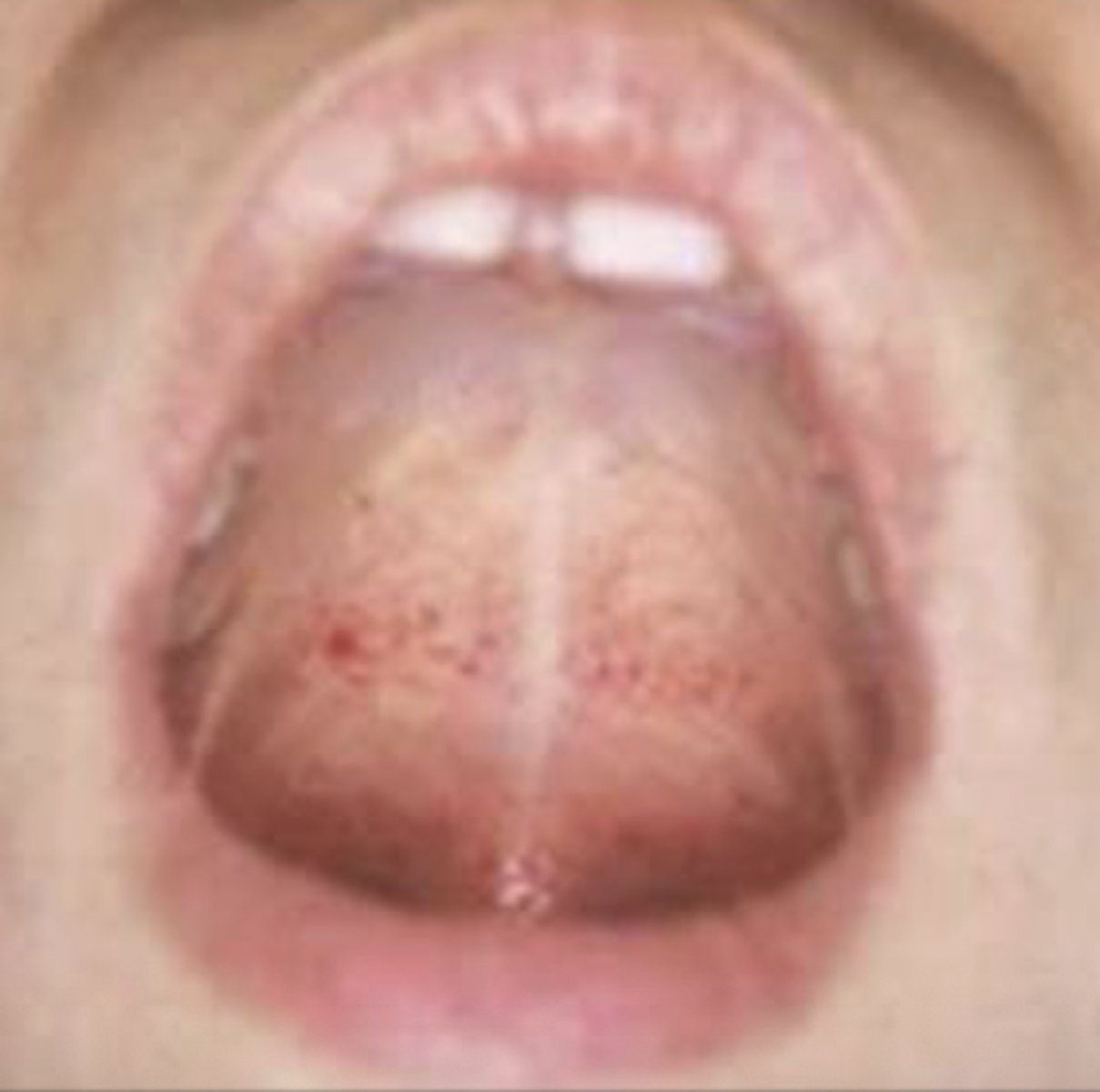
Define neglect
When a caretaker does not give care and protection such as:
- clothing
- food
- heat in cold weather
- clean living conditions - medical/dental care
- leaves people that need superivison alone for extended periods of time
Signs of neglect
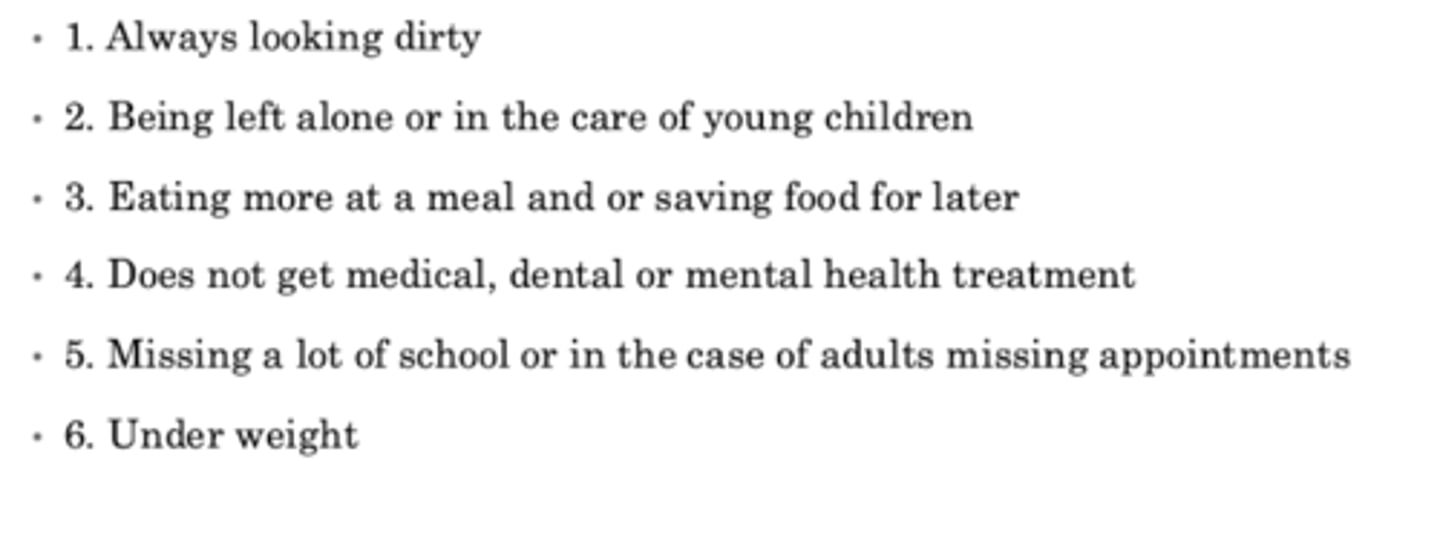
Define dental neglect
Willful failure of parent or guardian, despite adequate access to care, to seek and follow through with txt necessary to ensure a level of oral health essential for adequate function and freedom from pain and infection
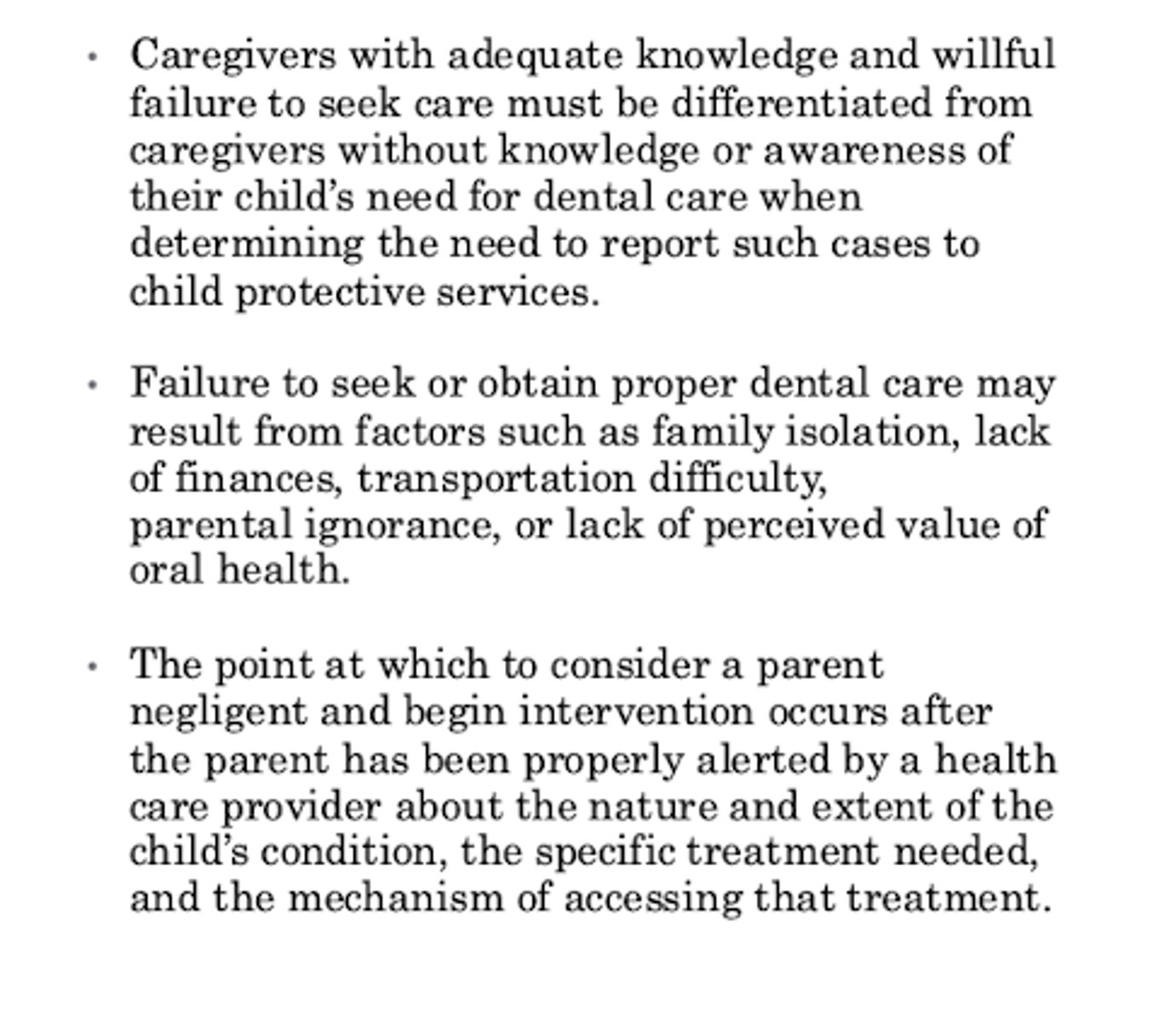
Factors considered necessary for the diagnosis of neglect
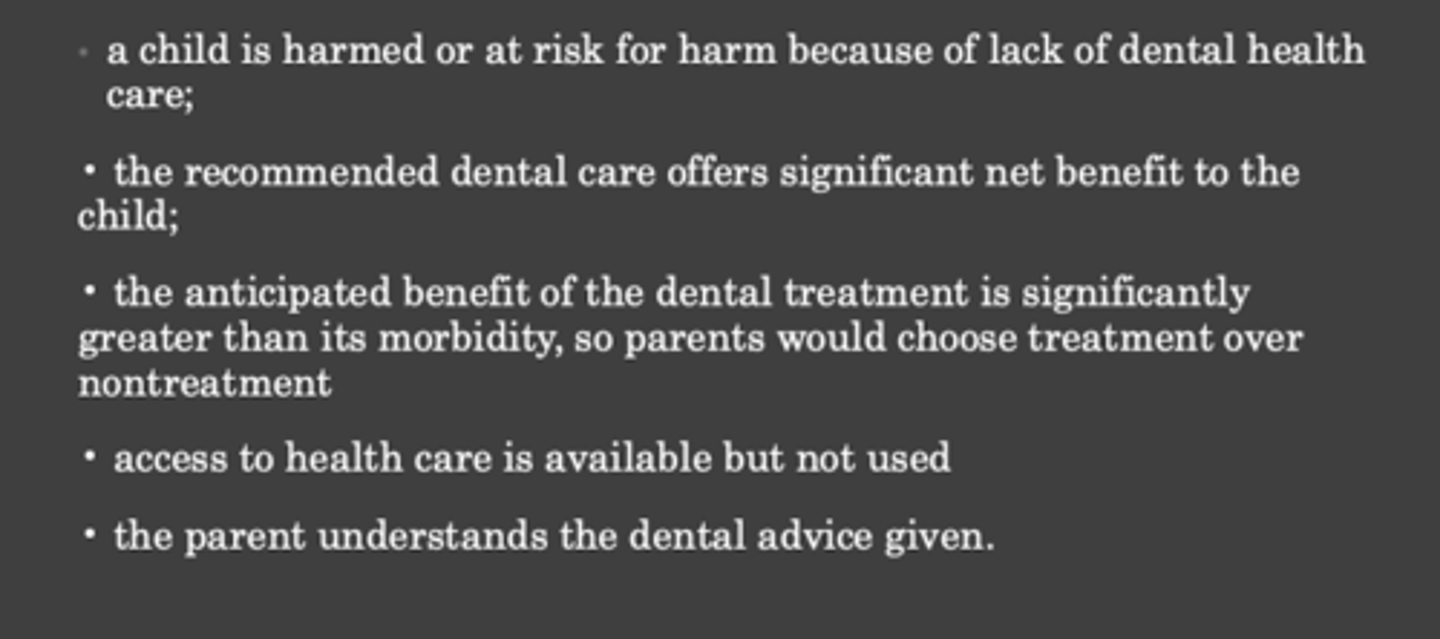
What should you do if you suspect abuse and depending on condition of the person
